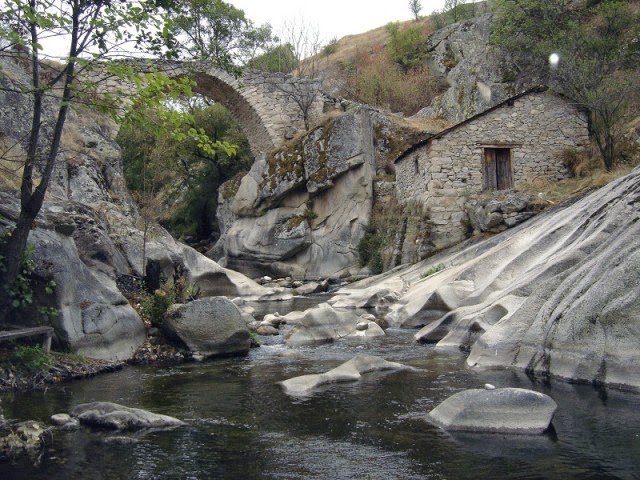Mariovo - A View into the Past and Ghost Villages Wild and cruel, yet quite picturesque, Mariovo land awakens interesting, pleasant, and mystic feelings in all who visit it.
Mariovo is a mountainous region in southern Macedonia known for its natural beauties and wonderful white traditional costumes. The Mariovo area is somewhat large but since there has been no urban development in these spaces over the past century, the region contains no actual towns, only rustic villages. Today Mariovo is like an open-air museum.
Situated at the elevation of 1050 meters and surrounded by the mountains of Selechka, Nidze, Kozjak, and Babuna, the region of Mariovo is one of the most interesting and most inaccessible areas in Macedonia. Its morphological features include barren and dry hills, deep stone river gorges, but also magnificent woodland areas in the higher regions of the mountains. Those majestic mountains of Mariovo area divide the Vardar part of Macedonia and the Aegean part of Macedonia.
The legend of Mara
To the north of the Nidzhe mountain is a hilly area with grasslands, canyons and rocks. Ancient villages with rustic stone houses are standing almost empty, and they are only connected by small unpaved roads. Some villages are almost completely deserted. It suffered heavily during WW1 and most of the remaining population left for cities during the 20th century.
It is said that Mariovo was named after the beautiful and brave girl Mara. The legend says that some turkish Pasha who has conquered the villages of Mariovo, has fallen in love with this girl and, enchanted by her beauty, was prepared to do everything to gain her love. But Mara’s father was not approving on it, because his daughter was a Christian, and the Turk was a Muslim.
The Pasha would not give up. Mara answered his persistence with one condition: she would become his wife, but the entire region, from the Poloski monastery, Selecka mountain, to the village by the name of Brod, then the Bitola region, the Nidze mountain and to the reach of Kozjak, to remain Christian and that not a single Turk should be inhabited there. The Pasha agreed to this condition, signed papers on that decision and took Mara with him. He took her on the road leading to the village of Dunje, Mara suddenly took the knife from her folds and killed herself. Taking away her life, she did not surrender to the pasha, who later, although he wanted to, could not annul the contract he previously signed.
By the power of this document, the guarantee that the entire region should remain Christian was respected. In the honor of the girl and her courageous act, and the love for her fellow people, the region was named Mariovo.
With only a little bit less than five hundred inhabitants, Mariovo is today almost completely deserted. Among the stones that make company to the large and fertile plains, among the many markings and directions that point the way to a temple of God or a shrine that once existed here, from time to time a fireplace can be observed, a house once in a while, the home to the most persistent who, besides everything, could not resist the extraordinary attractiveness of this picturesque region.
Witness of history
And amid these fairly devastated houses from which the curious and a bit puzzled eyes of the shepherds greet you, in one of the old villages, Manastirec, a real surprise awaits you. Among the fragile buildings and unmentioned yards, almost in the center of the village, there is the opulent basilica, the monastery church St. Nikola, an elegant beauty that reminds of the past times of wealth and well-being.
One of the most beautiful architecture constructions in the Mariovo’s area is known to be the stone bridge. The bridge spans over the Gradeshka River in an immediate nearness of the Mariovo’s village Zovikj. Under the bridge on one of the highest rocks there is a picture of the saint Gjorgi. This picture actually is remaining of the little church that existed there.
The wall of the bridge is built of huge rocks, under which goes the village river. Clear and cold water had made little canyon going through the cliffs. No one can really withstand to this beauty. One man simply stands in front of the dilemma: should we run an look for money or leave that killing fight with the day and night in order to breathe the life with full chest, in this kind of peacefulness?
In Vitolishta, Dunje, Staravina, and other villages, the ambience depicts the scenes and pictures of another, ancient time. The time here has stopped long time ago.
Take a walk across Dunje, a village with specific ancient Macedonian architecture. The noise of the population snuffed out long time ago along these stone walls, along the decade migration. How many people would come here if they had known about this kind of place, when a person can feel really alone, out of the civilization, at least for a moment to feel the smell of an adventure, but the escape from the chaos of our routine life?
Here, along this area, went true the Solun’s forward line, during the First World War. Then, Mariovo roared across it whole length. The remains of that time are everywhere, even the trenches and the bunkers where the soldiers were hiding.
There is a tiny church dedicated to Saint Eliah - Sveti Ilija made up of weapons, shells and barbed wire fence off the church, in a testament to eternal peace and a crypt for the soldiers who heroicly died in the battle. Yet nothing could prepare visitors for its breathtaking beauty, quietness and solitude, in contrast to the intolerable noise of the battle that raged there nerly 100 years ago.
One may not find gold or treasure during time spent in the Mariovo wilderness, but spending time in this fascinating and beautiful region of Macedonia, something much more valuable can be discovered …a hidden gem. Wild and cruel, yet quite picturesque, Mariovo land awakens interesting, pleasant, and mystic feelings in all who visit it.
- See more at:
http://www.independent.mk/articles/3495/Mariovo+-+A+View+into+the+Past+and+Ghost+Villages#sthash.JuInVpEQ.dpuf








